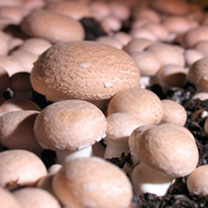How to Grow Mushrooms – A Guide to Growing Mushrooms
Try growing your own mushrooms! Kits offer an easy method of home-growing a number of different varieties.
A Basic Overview Guide for Home Growing Mushrooms
Growing mushrooms can be a rewarding and relatively simple process. Here’s a basic general guide to growing mushrooms at home:
Choose the Mushroom Type
There are many different types of mushrooms you can grow at home, such as oyster, shiitake, portobello or button mushrooms. Choose a variety that suits your taste and growing conditions.
Varieties of Mushroom
- Button Mushrooms – Small mushrooms, usually white
- Closed Cup Mushrooms – The most common type found in the supermarket
- Open Cup or Flat Mushrooms – Large, meaty mushrooms
- Chestnut Mushrooms – Similar to closed cup mushrooms but more flavourful
- Portobello Mushrooms – Open but not as large as Open Cup
- Shiitake Mushrooms – Japanese mushrooms ideal for oriental cooking
- Oyster Mushrooms – Subtle flavour, often used in pasta dishes
- King Oyster – Thick stemmed, large mushroom
- Porcini Mushrooms – flavourful Italian mushroom also known by the French name Cep
- Enoki Mushrooms – thin white stemmed mushrooms with little head used in East Asian dishes.
Obtain a Growing Medium
Mushrooms can be grown on various substrates, including straw, sawdust, coffee grounds, or even logs, depending on the species. You can purchase pre-made mushroom growing kits or prepare your own substrate.
Seed and plant suppliers sell mushroom kits in various forms, from mushroom spawn, plugs and logs to full growing kits (for both outdoors and the windowsill) with everything you need supplied, including full growing instructions.
Oyster and Shiitake mushrooms are often offered in kit form; chestnut and button mushroom spawn is easily available for home-growing.
Prepare your mushroom growing area
Mushrooms grow best in a dark, humid environment with good air circulation. You can use a dedicated growing room, a darkened area under the benches in a greenhouse, or even a closet or basement with proper conditions.
Some types of mushrooms are grown on logs, which are stacked up outside
Inoculate the substrate (spawning)
This involves introducing mushroom spawn, which is essentially the mushroom’s equivalent of seeds, into the chosen growing medium. You can purchase spawn from suppliers or use spores to inoculate your substrate.
With the mushrooms grown on logs, inoculated wooden dowels are inserted into holes drilled into the logs.
After inoculation, keep in a warm, dark place to allow the mycelium (the root-like structure of the mushroom) to colonize the growing medium. This process can take several weeks to many months with log grown mushrooms, depending on the type of mushroom you’re growing.
Provide proper conditions
Mushrooms require specific environmental conditions to grow successfully. This typically includes maintaining a consistent temperature, humidity, and proper air circulation. Mushrooms need a consistently moist environment to grow. Depending on your growing method, you may need to mist the growing area regularly or provide a means of maintaining humidity, such as a humidifier or misting system.
Different species have different optimal conditions, so be sure to research the specific requirements for the type of mushroom you’re growing.
Control pests and diseases
Keep an eye out for any signs of pests or diseases that could affect your mushroom crop. Maintaining cleanliness in your growing area and using sterile techniques during the inoculation process can help prevent issues. Mushroom fly will dramatically reduce a crop.
Fruiting
Once the mycelium has fully colonized the growing medium, it’s time to initiate the fruiting stage. This may involve exposing the container to fresh air, light, and slightly lower temperatures. Mist the growing medium regularly to maintain humidity, as mushrooms need a moist environment to grow.
Harvest your mushrooms
Depending on the species, mushrooms will typically be ready to harvest anywhere from a few weeks to several months after inoculation. Harvest them as and when they reach the desired size and firmness by gently twisting or cutting them from the substrate with a sharp knife.
Often the mushrooms will appear in flushes with some time between them. Follow specific guidelines for each species to encourage further growth.
Storage and Consumption
Store harvested mushrooms in a paper bag in the refrigerator and consume them within a few days for the best flavour and texture.
Spent Compost / Growing Media
Once your mushroom crop has finished producing, you can compost or dispose of the spent substrate. Depending on the material used, it may be excellent for use as garden mulch or compost.
Eating
- Mushrooms are delicious eaten both raw and cooked.
- They are a good source of vitamin D, vitamin B, potassium and antioxidants.
- Take a look through our selection of recipes for inspiration for cooking with mushrooms.
Remember, this is a basic overview, and the specific steps may vary depending on the type of mushroom you’re growing and the method you’re using. Be sure to research the specific requirements for the type of mushroom you want to grow for the best results. Additionally, consider starting with a small-scale operation to gain experience before scaling up your mushroom production.




